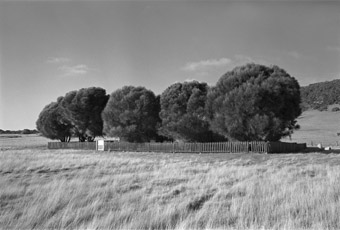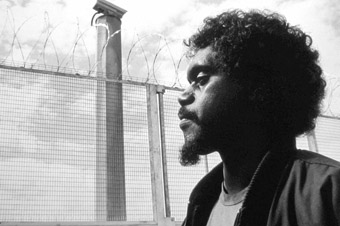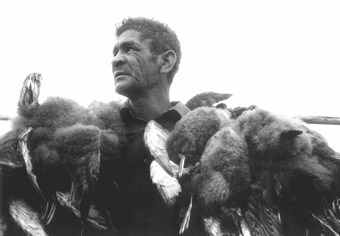 |
The Healing Garden, Wybalenna, Flinders Island, Tasmania from Portrait of a Distant Land, 2005. silver gelatin print copyright Ricky Maynard, courtesy Stills Gallery |
Indigenous Tasmanian speaker
The Healing Garden, Wybalenna, Flinders Island Tasmania is one of many images from Portrait of a Distant Land, a retrospective of Ricky Maynard’s photography staged by Sydney's MCA and exhibited at Cairns Regional Gallery. Initially the landscape is seemingly serene and rustic—grassland with several velvety trees enveloped by a forlorn picket fence. Apparently innocuous, the composition of the landscape draws you in, with its luminous gate and rickety fence that bind the spongy trees. What incredible trees. Am I looking at a sacred site, a site of worship? Only upon reading the accompanying text do I learn of the ghastly horror commemorated here, accentuating the burden Indigenous Australians have to bear and their determination to survive.
Ricky Maynard is an award-winning Aboriginal photographer who lives and works on Flinders Island and is one of the Ben Lomond/Cape Portland people. His finely crafted black and white prints are neatly framed in rosewood, but the images are sometimes raw and often haunting. Portrait of a Distant Land combines discrete lines of inquiry from five exhibitions over two decades of documentary photography. And to this overview Maynard adds the byline, “Do not forget these faces—they hold something you would not believe." Hence an individual's face, a description of circumstance, the surface of an environment, all imbue the collection with multiplicity and meaning.
In the early 1980s Maynard began his journey to capture through the camera his culture—landmarks, people, places and experiences which would otherwise have been lost or gone unrecognised. His dedication to documenting histories of Indigenous peoples is revealed in his considered choice of subject matter—certain eras, places, jobs, kinds of country and everyday life.
 |
Untitled from No More Than What You See series, 1994 copyright Ricky Maynard, image courtesy of the artist and Stills Gallery, Sydney |
This state is juxtaposed with indigenous triumphs. The portraiture from Returning To Places That Name Us 2000 is a series of large scale headshots, defiant in the face of horrible injustices. The photographs are inspired by the landmark High Court of Australia ruling that recognised the existence of traditional lands of the Wik people in Cape York, North Queensland. The images fill the gallery like Easter Island guardians. One such portrait, the face of Joe, Wik Elder, shows a wise and knowledgeable Aboriginal man fixing a penetrating gaze upon his lot. The white prickly beard, wiry hair, creases on the forehead and pursed lips suggest a steely presence. Joe appears to be missing an eye in the dark deepness of his face. I have to move several times past the glare from the gallery light, to see what is not there. Perhaps more considered composition, or Maynard magic.
 |
Athol Burgess from The Moonbird People series 1985-88, printed by the artist 2007 copyright Ricky Maynard. Image courtesy of Australian Institute of Aboriginal and Torres Strait Islander Studies, Canberra |
Portrait of a Distant Land provides a poignant and reflective expedition for the viewer. It offers cultural insights and gestures that are revealing of traditional and contemporary life. While reminding me of the challenges facing these people, I was left with a sense of hope for the reclaiming of Indigenous culture—exhibiting Ricky Maynard’s photography, especially his Wik work, here in Northern Queensland suggests the possibility that a viewer might find a relative staring back at them.
Portrait of a Distant Land is a touring exhibition from Museum of Contemporary Art Sydney and is a component of the Australia Council’s Australian Stories Initiative.
Ricky Maynard, Portrait of a Distant Land, Cairns Regional Gallery,
March 20–May 3
Rebecca Youdell is a founding member of Bonemap.
© Rebecca Youdell; for permission to reproduce apply to [email protected]








 back
back